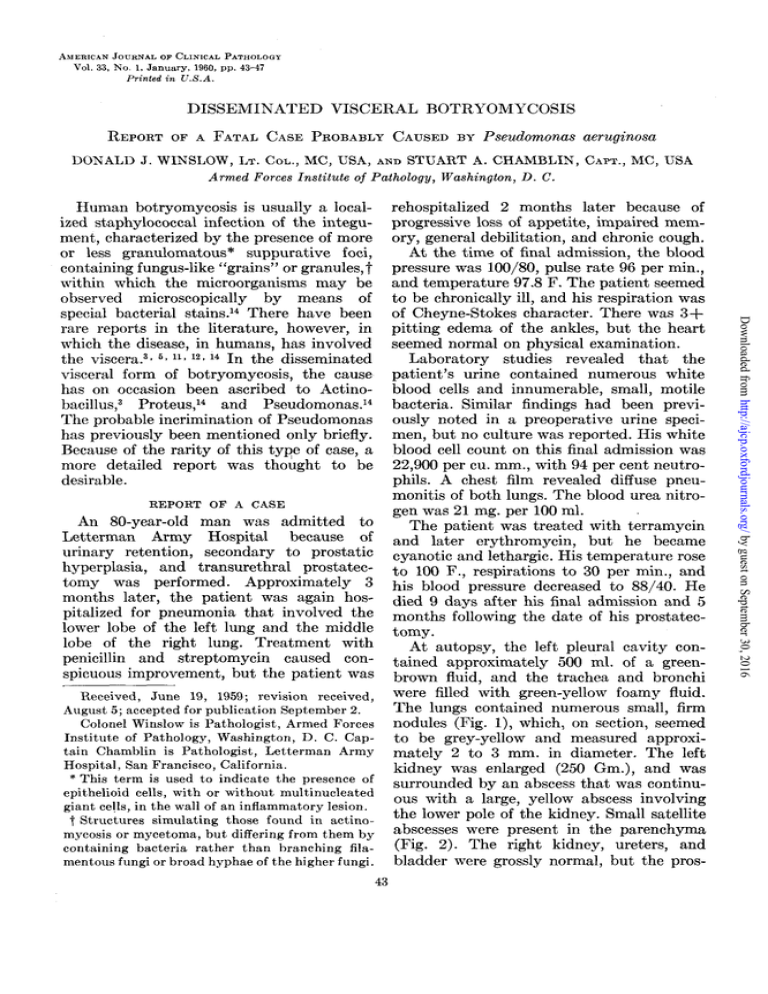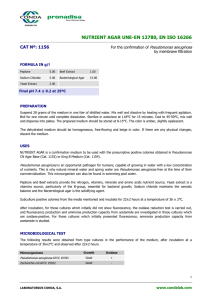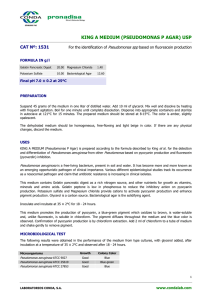Disseminated Visceral Botryomycosis: Report of a Fatal Case
advertisement

AMERICAN JOURNAL OP CLINICAL PATHOLOGY Vol. 33, No. 1, January, I960, pp. 43-47 Printed in U.S.A. DISSEMINATED VISCERAL BOTRYOMYCOSIS REPORT OF A FATAL CASE PROBABLY CAUSED BY Pseudomonas aeruginosa DONALD J. WINSLOW, LT. COL., MC, USA, AND STUART A. CHAMBLIN, CAPT., MC, USA Armed Forces Institute of Pathology, Washington, D. C. REPORT OF A CASE An 80-year-old man was admitted to Letterman Army Hospital because of urinary retention, secondary to prostatic hyperplasia, and transurethral prostatectomy was performed. Approximately 3 months later, the patient was again hospitalized for pneumonia that involved the lower lobe of the left lung and the middle lobe of the right lung. Treatment with penicillin and streptomycin caused conspicuous improvement, but the patient was Received, June 19, 1959; revision received, August 5; accepted for publication September 2. Colonel Winslow is Pathologist, Armed Forces Institute of Pathology, Washington, D. C. Captain Chamblin is Pathologist, Letterman Army Hospital, San Francisco, California. * This term is used to indicate the presence of epithelioid cells, with or without multinucleated giant cells, in the wall of an inflammatory lesion. f Structures simulating those found in actinomycosis or mycetoma, but differing from them by containing bacteria rather than branching filamentous fungi or broad hyphae of the higher fungi. 43 Downloaded from http://ajcp.oxfordjournals.org/ by guest on September 30, 2016 rehospitalized 2 months later because of progressive loss of appetite, impaired memory, general debilitation, and chronic cough. At the time of final admission, the blood pressure was 100/80, pulse rate 96 per min., and temperature 97.8 F. The patient seemed to be chronically ill, and his respiration was of Cheyne-Stokes character. There was 3 + pitting edema of the ankles, but the heart seemed normal on physical examination. Laboratory studies revealed that the patient's urine contained numerous white blood cells and innumerable, small, motile bacteria. Similar findings had been previously noted in a preoperative urine specimen, but no culture was reported. His white blood cell count on this final admission was 22,900 per cu. mm., with 94 per cent neutrophils. A chest film revealed diffuse pneumonitis of both lungs. The blood urea nitrogen was 21 mg. per 100 ml. The patient was treated with terramycin and later erythromycin, but he became cyanotic and lethargic. His temperature rose to 100 F., respirations to 30 per min., and his blood pressure decreased to 88/40. He died 9 days after his final admission and 5 months following the date of his prostatectomy. At autopsy, the left pleural cavity contained approximately 500 ml. of a greenbrown fluid, and the trachea and bronchi were filled with green-yellow foamy fluid. The lungs contained numerous small, firm nodules (Fig. 1), which, on section, seemed to be grey-yellow and measured approximately 2 to 3 mm. in diameter. The left kidney was enlarged (250 Gm.), and was surrounded by an abscess that was continuous with a large, yellow abscess involving the lower pole of the kidney. Small satellite abscesses were present in the parenchyma (Fig. 2). The right kidney, ureters, and bladder were grossly normal, but the pros- Human botryomycosis is usually a localized staphylococcal infection of the integument, characterized by the presence of more or less granulomatous* suppurative foci, containing fungus-like "grains" or granules,! within which the microorganisms may be observed microscopically by means of special bacterial stains.14 There have been rare reports in the literature, however, in which the disease, in humans, has involved the viscera. 3,6 ' u - 1 2 , u In the disseminated visceral form of botryomycosis, the cause has on occasion been ascribed to Actinobacillus,3 Proteus,14 and Pseudomonas.14 The probable incrimination of Pseudomonas has previously been mentioned only briefly. Because of the rarity of this type of case, a more detailed report was thought to be desirable. WINSLOW AND CHAMBLIN ' * * * « » Vol. S3 • tatic remnant contained numerous firm, yellow nodules. In the right lateral lobe of the prostate gland, there was an abscess filled with green-yellow pus. Postmortem cultures of the heart's blood, right lung, left lung, and left kidney all yielded growth of a microorganism identified as Pseudomonas aeruginosa. This microorganism was thought to be a contaminant, and was not further studied; unfortunately, the cultures were discarded by the laboratory technician. Microscopically, the prostate gland, left kidney, and both lungs were similarly involved by numerous discrete abscesses that contained granules (Fig. 3). These consisted of irregular particles which, with hematoxylin and eosin, were stained eosinophilically, peripherally, and partially basophilically centrally. Special stains for fungi, such as the Gomori methenamine-silver method and the Gridley stain, failed to reveal either the branching filaments of the Actinomycetaceae or the broad hyphae of higher fungi. The Downloaded from http://ajcp.oxfordjournals.org/ by guest on September 30, 2016 ,L SS'-A ( u PP er )- A portion of lung containing multiple botryomycotic lesions. (AFIP Neg. No. 58-9261-1). FIG. 2 (lower). A portion of kidney with some of the satellite botryomycotic lesions. (AFIP Neg. No. 58-9261-2). Jan. 1960 DISSEMINATED VISCERAL BOTRYOMYCOSIS 45 Downloaded from http://ajcp.oxfordjournals.org/ by guest on September 30, 2016 FIG. 3 •iippcri. Scciion nf lung, illiMr.-ning :i iliM-ivu1 1»itryomycotic lesion with granules in tne center. (AFIP Neg. No. 59-4395). Hematoxylin and eosin. X 165. FIG. 4 (lower). A granule in the lung, with bacilli in the central portion. (AFIP Neg. No. 59-4444). Giemsa. X 1410. 46 W I N S L O W AND Brown and Brenn and Goodpasture-MacCallum Gram stains, however, both revealed myriads of Gram-negative, rod-shaped particles in the central portions of the granules. These particles measured approximately 0.5 M in diameter and 1 to 2 n in length. In Giemsa-stained sections, their structure was more clearly delineated and most consistent with that of bacilli (Fig. 4). DISCUSSION It seems of considerable interest that the kidneys and lungs were involved in the present instance and also in Case 1 of the article on botryomycosis by one of us (D. J. W.).14 In the latter instance, the patient, a 60-year-old Negro man, had a severe, persistent, and refractory urinary tract infection caused by a Proteus microorganism. At autopsy, the kidneys and lungs contained numerous botryomycotic abscesses from which a Proteus microorganism was isolated. It may be of significance that the patient described in the present report had motile bacilli and numerous white blood cells in his urine, before and also after the transurethral prostatectomy. Unfortunately, there is no report of any urine culture. Nevertheless, the clinical history, the sites of involvement, the type of microorganism, and the morphology of the lesions certainly are suggestive that the portal of entry was the genito- urinary tract, with dissemination to the lungs by way of the blood stream. The natural or acquired resistance to various antibiotics and the dissociative behavior of such Gram-negative bacilli as Pseudomonas aeruginosa and Proteus has been demonstrated. 1 ' 2 ' 4 ' 6 " 9 ' 18 The ability of Pseudomonas to cause botryomycotic lesions is perhaps somewhat surprising in view of the usual pathologic picture that has been associated with this microorganism13 in the past. In this respect, however, it must be recalled that Magrou10 was able to produce experimental botryomycosis with staphylococci by means of using a minimal dose with which to infect rabbits. He was of the opinion that the development of botryomycotic granules depended upon a delicate balance between the virulence of the microorganisms and the resistance of the host. Now, in the present era of antibiotics, this natural balance can be modified by artificial means. 1 ' 8i 13 As a consequence, it may be possible for certain bacteria to produce botryomycotic types of lesions even though they would not ordinarily do so. SUMMARY This paper deals with the findings in a fatal case of disseminated visceral botryomycosis, probably caused by Pseudomonas aeruginosa. To the authors' knowledge, this is the first reported instance of botryomycosis thought to be caused by Pseudomonas. There are some similarities to a previously published case of disseminated visceral botryomycosis presumed to be caused by a Proteus microorganism. In both instances, it seems likely that the portal of entry was the genitourinary tract, and that dissemination to the lungs occurred by way of the blood stream. The suggestion is offered that the etiology of botryomycotic types of lesions may possibly be influenced by the artificial modification of the balance between virulence of the microorganism and host resistance, as an effect of therapy with antibiotics. SUMMARIO I N INTERLINGUA Es presentate le constatationes in un caso mortal de disseminate botryomycosis vis- Downloaded from http://ajcp.oxfordjournals.org/ by guest on September 30, 2016 On the basis of the microscopic findings, we think that the case reported here is another example of disseminated visceral botryomycosis. The absence of branching filaments or broad hyphae in any of the numerous granules, stained by various methods and examined microscopically, would seem to rule out the possibility of actinomycosis or some other fungous disease. On the other hand, the presence of Gram-negative bacilli in the granules and the growth of Pseudomonas aeruginosa in cultures of heart's blood, lung, and left kidney support the presumptive diagnosis of disseminated Pseudomonas infection. We have not found in the literature any reports of disseminated visceral botryomycosis caused by Pseudomonas organisms. Vol. 33 CHAMBLIN Jan. 1960 DISSEMINATED VISCERAL REFERENCES 1. ALEXANDER, H . E . : Origin of resistance of bacteria and therapeutic implications. Pediatrics, 1: 273-278, 1948. 2. ALEXANDER, H . E . , AND L E I D Y , G.: Mechanism of emergence of resistance t o streptomycin in 5 species of Gram-negative bacilli. Pediatrics, 4: 214-221, 1949. 3. AUGER, C . : H u m a n actinobacillary and staphylococcic actinophytosis. Clin. P a t h . , 18: 645-652, 1948. Am. J. 4. E I S E N B E R G , G. M . , W E I S S , W., AND F L I P P I N , H . F . : K a n a m y c i n : in vitro activity against selected problem pathogens. Am. J . Clin. P a t h . , 3 1 : 267-272, 1959. 5. F I N K , A. A . : Staphylococcic actinophytotic (botryomycotic) abscess of t h e liver with pulmonary involvement. Arch. P a t h . , 3 1 : 103-107, 1941. 6. F R A N K , P . F . , W I L C O X , C , AND F I N L A N D , M . : In vitro sensitivity of Bacillus protevs and Pseudomonas aeruginosa t o seven antibiotics. J . L a b . & Clin. Med., 35: 205-214, 1950. 7. GABY, W. L . : Study of dissociative behavior of Pseudomonas aeruginosa. J . Bact., 5 1 : 217-234, 1946. 8. GARRARD, S. D . , RICHMOND, J . B . , AND H I R S C H , M . M . : Pseudomonas aeruginosa infection as a complication of therapy in pancreatic fibrosis. Pediatrics, 8: 482-488, 1951. 9. K E R B Y , G. P . : Pseudomonas aeruginosa bacteremia. Am. J . D i s . Child., 74: 610615, 1947. 10. MAGROU, J . : Les formes actinomycotiques du staphylocoque. A n n . Inst. Pasteur, 33: 344-374, 1919. 11. MOTJLONGUET, P . , AND G A S S U E , L . : Infection staphylococcique du rein. Un exemple de vraie botryomycose. Compt. rend. soc. anat., 6: 37-38, 1946. Cited b y Auger. 3 12. O P I E , E . L . : H u m a n botryomycosis of t h e liver. Arch. I n t . Med., 11: 425-439, 1913. 13. STANLEY, M . M . : Bacillus pyocyaneus infections. A review, report of cases, and discussion of newer t h e r a p y including streptomycin. Am. J . Med., 2 : 253-277, 1947. 14. W I N S L O W , D. J.: Botryomycosis. P a t h . , 35: 153-167, 1959. Am. J. Downloaded from http://ajcp.oxfordjournals.org/ by guest on September 30, 2016 ceral, probabilemente causate per Pseudomonas aeruginosa. Secundo le informationes del autores, isto es le prime reportate caso de botryomycosis supponitemente causate per pseudomonas. Es noteta certe similaritates con un previemente publicate caso de disseminate botrymycosis visceral, supponitemente causate per un organismo proteus. In ambe iste casos il pare probabile que le porta de accesso esseva le vias genitourinari e que le dissemination in le pulmones occurreva via le circulation del sanguine. Es formulate le notion que le etiologia de lesiones del typo botryomycotic es possibilemente influentiate per modificationes artificial del balancia inter le virulentia del microorganismo e le resistentia del hospite, i.e., modificationes effectuate per therapias a antibioticos. 47 BOTRYOMYCOSIS



